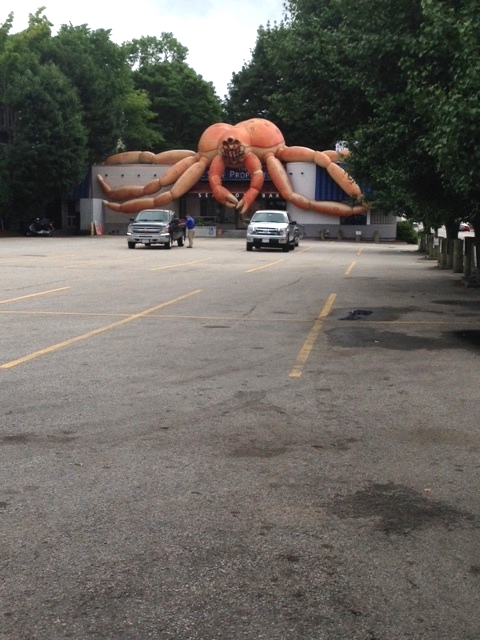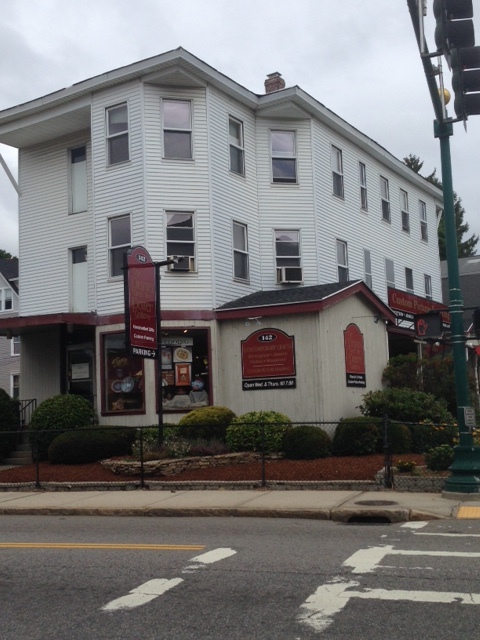So, we've reviewed the two major planning paradigms this past week and we have traveled to Boston to see how those models manifest in the North End and the former West End. Now, it's time to tiptoe back to Worcester. Let's see how these two models compare right here at home. We're traveling down Highland Street towards downtown. Look at the two photos below and here is the question: Which photo represents "Robert Moses" urban renewal and which photo represents the "Jane Jacobs" ideal?
So, if you guessed the Sole Proprietor in the top photo as "Robert Moses", you would be correct. Across the street, the building that houses the framing and arts store, The Prints and the Potter, is Jane Jacobs personified. Let's look closely here to tell them apart.
Sole Proprietor, A Hint of Robert Moses
Ok, now before you think I'm hating on the good old Sole, let me tell you that I've had my fair share of yummy salmon in that building over the years. It's a special treat to dine there and we love it when Buster, the Crab comes back to town in the summer. So, please don't think Jane Jacobs in the Woo is picking on the Sole. We're "solely" looking at how buildings interface with the surrounding physical environment. How does a project enhance or detract from a thriving street life?
So, here's the thing about the Sole: This one restaurant has killed the density in this neighborhood! The one restaurant cum adjacent parking takes up practically one full city block. This is an example of a single use of a property. Only meals are served here. People aren't living here on this huge block. People have no other businesses or offices to go to on this block. It's only the Sole. That's it, folks. So, this block is only alive when the Sole is open. Otherwise, check out the empty parking lot around 10:45 on a Monday morning:
The parking lot seems to go on and on and on.... Once, this block was probably a mix of residential and commercial spaces, densely packed, bringing vitality to the street. This important density was razed to build this parking lot. Now, we have asphalt and temporary housing for cars. People drive here, park, eat their fish and then probably leave, detracting from the vitality of this neighborhood. The Sole is closed now and consequently, this whole city block is essentially dead.
Also, please note that you will see this pattern over and over and over again. The front door to the Sole doesn't face Highland Street, does it? No, the Sole is closed to the main drag and fronts onto its huge parking lot. The expectation is clear: Diners will drive there, enter and then exit to their cars. We pointed out this model at the library and the YWCA as well.
Jane Jacobs Still Alive on Highland
If you take a close look at the photo above of the Prints and the Potter building, you will see that the storefronts on the lower floor are topped by upper floors where people actually live and work. This model of storefronts at street level and housing above is typical mixed use that Jane Jacobs celebrated as a vital component of a thriving community.
This same model (retail on the street level and homes/offices above) is also apparent across the street from the Sole as well. One can see some pedestrians along the sidewalk. There are places to go and things to do and see here on this side of the street. You can stop off for a cup of coffee, go to the convenience store to pick up a newspaper, buy a juice and talk with Dante and Martha at their Pure Juz shop around the corner, get a haircut or just head back to your apartment upstairs or around the corner.
On this side of the street, one has many reasons to be out and about on the sidewalk. If you sit and observe the outside scene for a spell, you will also notice that when pedestrians get to the block of the Sole, many will cross the street to the other side. Why? Maybe it is in our psychology to want to be in safely, dense interesting spaces. Who wants to pass by a parking lot, whether empty or filled with cars outside the Sole?





